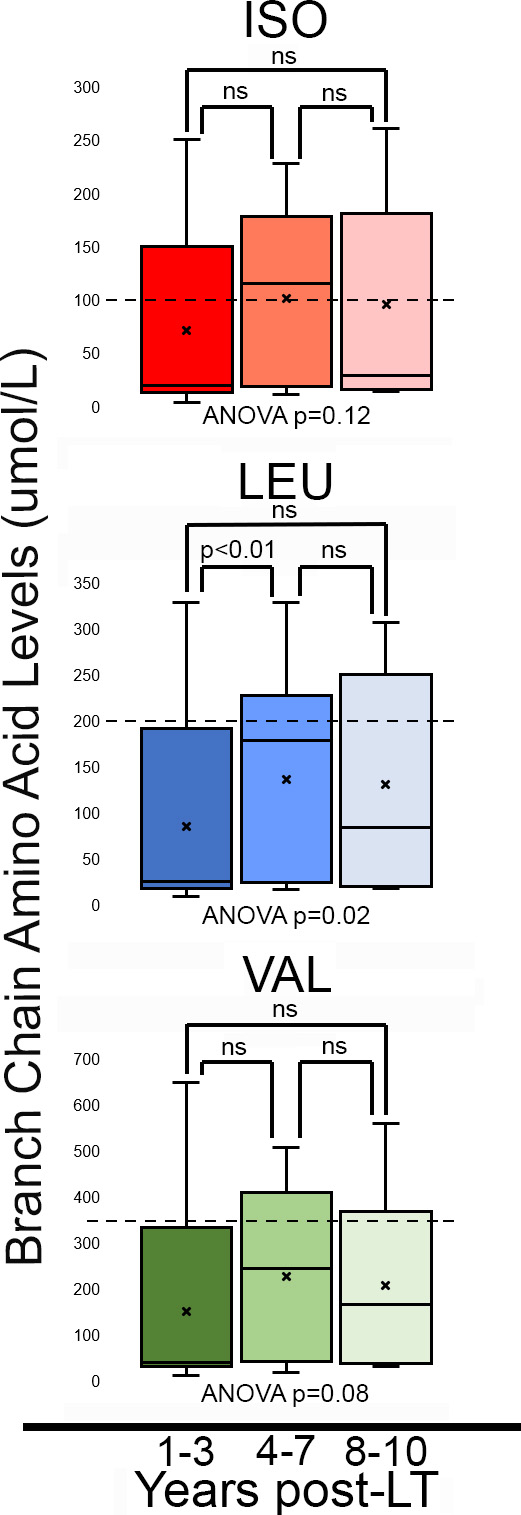Long-Term Metabolic Control and Health Outcomes in Maple Syrup Urine Disease Following Liver Transplantation in Children and Young Adults
C. Ewing1, K. Soltys2, K. Strauss3, G. Mazariegos2, R. Sindhi2, J. Vockley2, P. McKiernan2, R. Squires2, G. Bond2, A. Khanna2, J. Squires2
1School of Medicine, University of Pittsburgh, Pittsburgh, PA, 2Children's Hospital of Pittsburgh, Pittsburgh, PA, 3Clinic for Special Children, Strausburg, PA
Meeting: 2020 American Transplant Congress
Abstract number: 587
Keywords: Liver, Metabolic disease, Outcome, Pediatric
Session Information
Session Time: 3:15pm-4:45pm
 Presentation Time: 4:15pm-4:27pm
Presentation Time: 4:15pm-4:27pm
Location: Virtual
*Purpose: Determine outcomes and branch-chain amino acid (BCAA – leucine [LEU], isoleucine [ISO], and valine [VAL]) levels at 1-3, 4-7, and 8-10 years for patient’s status-post liver transplant (LT) for MSUD.
*Methods: Single center, retrospective chart review of patients with MSUD s/p LTx at the Children’s Hospital of Pittsburgh. BCAA levels at 1-3, 4-7, and 8-10 years post-liver transplantation were obtained with data related to clinical outcomes. Normal reference ranges (umol/L) for ISO, LEU, and VAL were 30 – 100, 30 – 200, and 70 – 350, respectively. Student t-test and single factor ANOVA analysis were performed.
*Results: 88 LT were performed for MSUD from 1/1/2004 – 6/30/2019. 10 patients were excluded from the analysis due to inadequate records for review (n=6) or did not meet minimum follow-up period (1 yr) from LT for inclusion (n=4) thus 78 patients (male/female 40/38) were included in the analysis. Mean age at LT was 11.7 yrs. Following LT, all patients were managed with an unrestricted protein diet. Patient and graft survival were 100% and 99% respectively. One patient underwent re-transplant for hepatic artery thrombosis and subsequent biliary fibrosis. Mean ISO levels (umol/L) and standard deviation at 1-3, 4-7, and 8-10 yrs post-LT were 71.2 (SD 84.1), 101.9 (SD 81.5), and 95.7 (SD 87.3) (p=0.12). Mean LEU levels (umol/L) and standard deviation at 1-3, 4-7, and 8-10 yrs post-LT were 85.1 (SD 99.4), 136.7 (SD 110.0), and 131.1 (SD 117.3) (p=0.02). Mean VAL levels (umol/L) at 1-3, 4-7, and 8-10 yrs post-LT were 150.6 (SD 185.8), 226.2 (SD 183.3), and 207.8 (SD 181.8) (p=0.08). (Figure 1)
*Conclusions: LT for MSUD enables excellent long-term survival and metabolic control on an unrestricted protein diet. While significant increases were noted in mean LEU levels (p=0.02) and trends were seen in both ISO (p=0.12) and VAL (p=0.08), overall mean values were near or below normal lab values. Variations in post-LT BCAA levels were not associated with any metabolic crises.
To cite this abstract in AMA style:
Ewing C, Soltys K, Strauss K, Mazariegos G, Sindhi R, Vockley J, McKiernan P, Squires R, Bond G, Khanna A, Squires J. Long-Term Metabolic Control and Health Outcomes in Maple Syrup Urine Disease Following Liver Transplantation in Children and Young Adults [abstract]. Am J Transplant. 2020; 20 (suppl 3). https://atcmeetingabstracts.com/abstract/long-term-metabolic-control-and-health-outcomes-in-maple-syrup-urine-disease-following-liver-transplantation-in-children-and-young-adults/. Accessed December 24, 2025.« Back to 2020 American Transplant Congress

